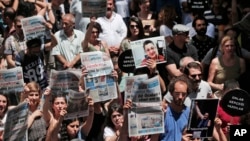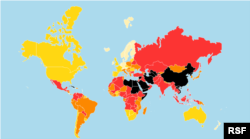Reporters Without Borders accuses him of engaging in “hate speech” against journalists. Freedom House questions whether he believes in the fundamental principles of press freedom. And the Committee to Protect Journalists, which last year labeled him an “unprecedented threat” to global media freedom, says things haven’t gotten any better since he took office.
That’s just a sampling of the kind of blistering language leading media rights groups use to describe U.S. President Donald Trump in several reports published ahead of World Press Freedom Day, May 3.
Taken together, the reports amount to a stunning rebuke of the U.S., which has long seen itself as a standard-bearer of free speech and a model for countries around the world.
Watch: Global Press Freedom at Tipping Point,' Report Warns
National political discourse
The outrage stems from Trump’s verbal attacks on the news media since entering the national political scene.
Trump has referred to the press as the “opposition party.” He’s said they’re “among the most dishonest human beings on Earth.” He regularly accuses journalists and media outlets he doesn’t like of spreading “fake news.” He’s even called the press the “enemy of the people.”
This week, media rights groups returned the favor.
“No U.S. president in recent memory has shown greater contempt for the press than Trump has in his first months in office,” warned Freedom House in its yearly report on global press freedom released Friday. “Such comments suggest a hostility toward the fundamental principles and purposes of press freedom.”
In its World Press Freedom Index, Reporters Without Borders (RSF) said Trump’s actions “compromise a long U.S. tradition of defending freedom of expression” and are helping spark a worldwide decline in media rights.
White House officials did not respond to VOA’s request for comment, but in the past have insisted Trump respects freedom of speech and is only criticizing outlets that he thinks treat him unfairly.
Democracies suffering
Trump is far from the only world leader to make slamming the media a pastime. In fact, it’s part of a larger trend of eroding press freedom in democracies around the world.
RSF specifically points to Canada, where anti-terrorism laws have raised concerns about government spying on journalists; Poland, where new laws give authorities greater control over media outlets; and Britain, where media bashing played a prominent part of the so-called Brexit campaign to leave the European Union.
Even in the United States, many press freedom concerns predate Trump.
Media rights groups also criticized former President Barack Obama’s crackdown on federal officials who leak information to journalists, as well as his attempts to limit media access at the White House.
“Democracies began falling in the Index in preceding years and now, more than ever, nothing seems to be checking that fall,” said RSF, which warned media rights have “never been so threatened” as they were during the past year.
Over the past year, media rights deteriorated in nearly two-thirds of the countries measured by RSF. Global press freedom is at its lowest point in 13 years, according to Freedom House’s metric, which estimates that just 13 percent of the world’s population lives under a free press.
US institutions still healthy
The U.S. itself hasn’t slipped very far in either group’s metric.
According to Reporters Without Borders, the U.S. fell two spots, to 43rd place, in 2017. Freedom House, which uses an aggregate score, calculates the U.S. dropped two points — from 21/100 to 23/100.
But despite Trump’s verbal attacks on journalists, the overall state of press freedom in the U.S. remains strong, thanks in part to constitutional safeguards.
“We are very concerned by the kind of rhetoric we’ve seen Trump make as president in 2017, [but] we recognize the vibrancy of U.S. media and its strong institutions,” Jennifer Dunham, research director at Freedom House, said. “The overall environment hasn’t suffered a huge amount.”
Worldwide impact?
Perhaps of greater concern is the international impact of Trump’s treatment of the media. Even before he won the election, the Committee to Protect Journalists warned Trump was an “unprecedented threat” to global press freedom.
Those concerns were heightened after several authoritarian governments, including in China and Cambodia, borrowed Trump’s language or explicitly referenced his actions as justification for mistreating their own media.
“The hate speech used by the new boss in the White House and his accusations of lying also helped to disinhibit attacks on the media almost everywhere in the world,” RSF’s Delphine Halgand warned.
That amounts to a major role reversal for a country that has long portrayed itself as a beacon for free speech. And it shows that what happens in the U.S. carries a special weight, Freedom House warned.
“Further weakening of press freedom in the United States,” it warned, “would be a setback for democracy everywhere.”










